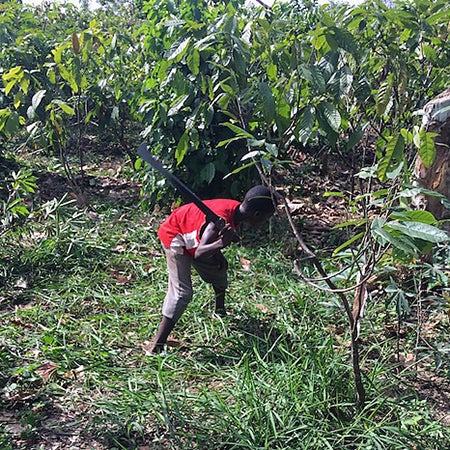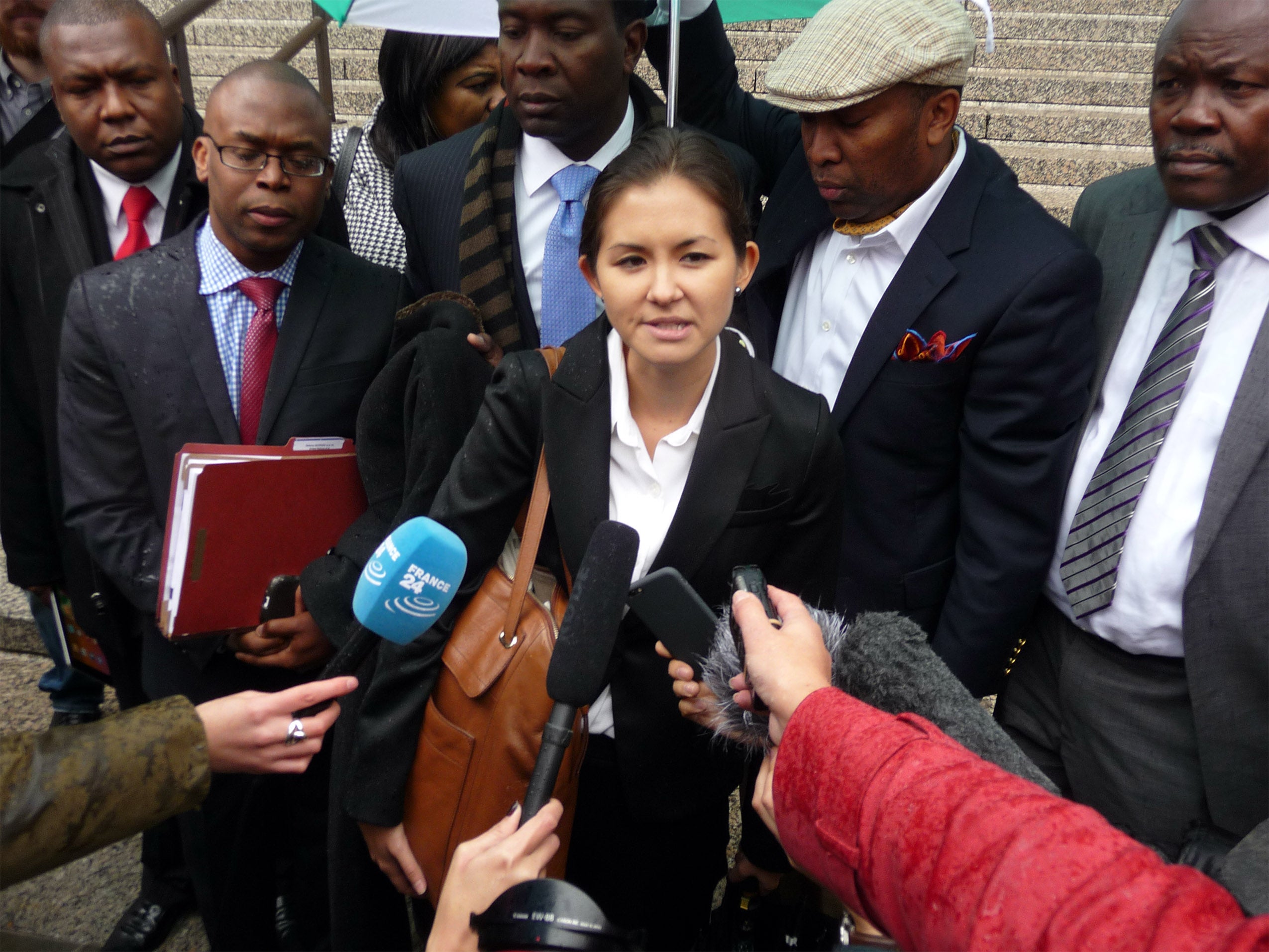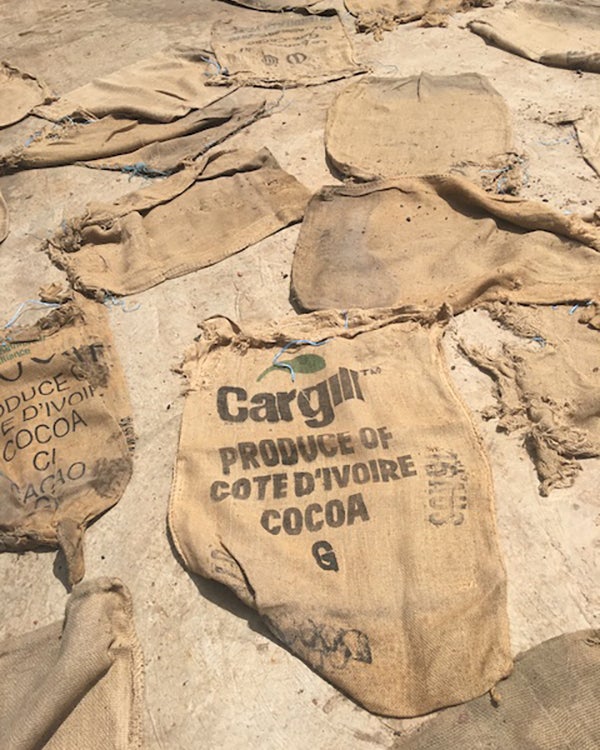via Harvard Law Today
by Dana Walters

On Dec. 1, 2020, the Supreme Court of the United States heard oral arguments in Nestlé v. Doe and Cargill v. Doe—a pair of corporate human rights cases against U.S.-based chocolate companies for their role in aiding and abetting child slavery in West Africa. Despite repeated promises from chocolate companies to curtail the practice, the problem remains far from fixed, with some estimates finding as many as 1.56 million children aged five to seventeen forced to harvest cocoa in Côte d’Ivoire and Ghana in 2018 and 2019 alone. The plaintiffs are six former child slaves who allege they were trafficked from Mali and forced to work in Côte d’Ivoire cocoa farms. The plaintiffs make use of the Alien Tort Statute (ATS), a provision of the First Judiciary Act of 1789 that has allowed foreign nationals to pursue accountability for human rights violations in U.S. courts over the past several decades.
In October, the International Human Rights Clinic at Harvard Law School filed an amicus curiae brief on behalf of legal historians in the consolidated cases against the chocolate companies. A student clinical team—Emily Ray ’21, Jasmine Shin ’21, Allison Beeman ’22, and Zarka Shabir ’22—under the supervision of Tyler Giannini, clinic co-director, worked with the amici on the brief. Amici were Professors Barbara Aronstein Black, Columbia Law School, Nikolas Bowie ’14, Harvard Law School, William R. Casto, Texas Tech University School of Law, Martin S. Flaherty, Fordham School of Law, David Golove, New York University Law School, Eliga H. Gould, University of New Hampshire, Stanley N. Katz, Princeton University, Samuel Moyn ’01, Yale Law School, and Anne-Marie Slaughter ’85, Princeton University and CEO of New America.
The Human Rights Program (HRP) at HLS spoke with the team about the ATS, their brief, and why the SCOTUS argument matters for human rights and corporate accountability.
Human Rights Program: What is at stake in the case?
Emily Ray: The ATS has been a key tool for many survivors of human rights abuses who have been unable to find justice in domestic court systems in their own countries or through international bodies like the International Criminal Court. For years, the ATS was groundbreaking because it allowed foreign plaintiffs to bring civil claims in U.S. courts for torts that violate the law of nations. The Supreme Court has placed restrictions in recent years on the statute, and this case decides, among other issues, whether the ATS can be used to bring cases against American corporations who have perpetrated or assisted in the perpetration of human rights abuses around the world. What the Supreme Court decides will have far reaching effects on that question.
Zarka Shabir: For me, what’s at stake is the idea that a U.S. corporation can be held liable in the United States for its involvement in rights violations regardless of where it commits them. It’s the idea that a corporation cannot, simply by virtue of being a corporation, violate accepted international law with impunity. One of the questions in the case is whether the ATS should permit claims against natural persons but not corporate entities, as Nestlé and Cargill have argued. During oral arguments, several Justices pressing counsel for the companies and the U.S. government on that point. Across the globe, an increasing number of countries have recognized that corporations cannot be left immune and without scrutiny. This case presents an opportunity for the United States to stay on track with this global trend.
Tyler Giannini: One of the reasons the First Congress passed the ATS was to send a signal to other nations that the United States would uphold the rule of law and that it could be trusted as part of the international community. This was especially true as a young nation at the time. While it’s no longer a new nation, the question of whether the U.S. will uphold basic principles of law and human rights has come under scrutiny again in recent years. As we said in the brief, it’s well established that a nation should hold its own citizens to account and not let action on its territory offend other countries and accepted international norms. The Court has the chance to affirm this idea in this case and to make clear that U.S. corporations can’t aid abuses like child slavery.
Jasmine Shin: Simply put, what’s at stake in this case is justice for the six plaintiffs who were trafficked and forced to endure unimaginable conditions. This case was first filed fifteen years ago, and these plaintiffs, who are now in their thirties, have not been able to have their day in court.

HRP: How does this case factor into the evolving jurisprudence around the ATS?
ER: The ATS was first used in the modern context in Filártiga v. Peña-Irala, a 1980 opinion that allowed a plaintiff from Paraguay to bring a suit against the man who had tortured and killed her brother. This landmark case opened up decades of litigation. In recent years, the Supreme Court has whittled down the reach of the ATS and significantly limited the types of cases where it can be used. The question here is whether this case will continue to narrow the statute’s scope or not.
TG: The Court’s decisions in the past have demonstrated a concern for how these cases affect U.S. foreign policy. The Court’s 2013 decision in Kiobel v. Royal Dutch Petroleum Co. held that cases brought under the ATS must be connected in a significant way to the territory of the United States. In 2018, the Court considered the ATS again in Jesner v. Arab Bank, and this time, held that no foreign corporation could be liable under the ATS. The current cases sit in this landscape, with the Court now addressing the question of whether the claims against domestic corporations will be permitted.
Allison Beeman: Along with the question of liability for domestic corporations, the question that got the most attention at oral argument was whether and how the ATS covers claims of aiding and abetting, especially those with a connection to U.S. territory. Aiding and abetting liability is an important aspect of corporate accountability because corporations are rarely principal offenders of human rights abuses abroad. In the oral argument, a number of Justices questioned whether excluding aiding and abetting liability entirely was consistent with international principles. The other element that got a good deal of attenti
on was where to draw the line on aiding and abetting. A company like Nestlé has a huge amount of influence over the market and the ability to control whether abuses are committed by their sources or subsidiaries. A finding that courts do have jurisdiction over U.S. corporations and over aiding and abetting claims would maintain one of the few remaining avenues to hold corporations accountable for human rights violations under the ATS.

HRP: What does the amicus curiae brief you submitted argue?
ER: There are so many important issues implicated in this case that a total of 18 amicus briefs were filed supporting the plaintiffs. Our particular brief focuses on the history of the ATS, going all the way back to the 1700s to set the stage for the First Congress’ decision to pass the ATS and discuss the Statute’s early application. We argue that the history plainly shows the ATS was intended to meet the young United States’ international obligations under the law of nations and that the First Congress understood that the law of nations required a broad civil remedy for harms committed on U.S. territory or by U.S. subjects anywhere in the world. The brief also argues that, although the modern corporation did not exist in 1789 when the ATS was passed, historical versions of the corporation faced tort liability and all other signs indicate that the First Congress would not have intended to create an exception for corporations under the ATS. Many of the Justices believe that the best way to interpret a statute is to look at the original meaning intended by Congress. We believe that under such an originalist interpretation of the ATS, the Court should recognize domestic corporate liability as well as aiding and abetting liability, preserving the broad avenues of recourse for law of nations violations intended by the First Congress.
Understanding the historical nuances of a statute with such an important modern impact was an entirely new dimension of law school for me. We had the opportunity to work with a set of brilliant historians on some very complex questions and it was a real privilege to translate their work into what we hope were convincing legal arguments.
Emily Ray ’21
AB: A set of materials from Thomas Jefferson and Edmund Randolph played an important role in our brief and the oral argument. At the time the ATS was first being implemented, Jefferson was the Secretary of State and Randolph was Attorney General in the first Washington administration. One of the amici who signed onto the brief, Professor David Golove (NYU), had recently uncovered a set of documents and generously shared them with us. The documents included a 1792 opinion from Jefferson that quoted the ATS directly, noting that the Statute would provide civil jurisdiction over a set of incidents involving law of nations violations committed by U.S. citizens in Spanish and French territories. The materials show that founding-era figures understood the U.S. to be responsible for holding its own subjects accountable for harms committed abroad and that the ATS was a tool to avoid or mitigate foreign policy tensions that could arise from such harms. A central tent of our brief is that, that from the very beginning, the ATS was understood to provide a remedy for the actions of U.S. citizens.
HRP: What did you learn in the course of working on the brief?
ER: I learned so much more than I ever thought I would or could about the 1700s—I will say that this is the first time my complete memorization of the Hamilton soundtrack has been useful in law school! Understanding the historical nuances of a statute with such an important modern impact was an entirely new dimension of law school for me. We had the opportunity to work with a set of brilliant historians on some very complex questions and it was a real privilege to translate their work into what we hope were convincing legal arguments.
ZS: More than anything, I think this process taught me the value and importance of working with people who share your belief in a particular idea and are willing to approach it from different perspectives, without losing sight of the collective goal. Reading the amicus briefs in this case illuminated the range of arguments supporting the same fundamental idea—that corporations cannot be immune and must be held liable for their actions.

Credit: International Rights Advocates
HRP: How did the oral arguments go?
AB: After learning so much about the case, it was interesting to hear the questions each Justice chose to ask. It was promising to hear fairly strong challenges against Nestlé’s legal arguments from even the more conservative Justices. Justice Gorsuch framed the corporate issue as a question of corporate exemption from liability and Justice Kavanaugh suggested that a finding for Nestlé may effectively gut the Statute. The history was also certainly relevant on a number of fronts, and we heard the Justices and attorneys discuss most of the historical examples and arguments in our brief during the hearing. For example, Paul Hoffman, the lawyer arguing for the plaintiffs, mentioned examples from our brief to argue that the founders originally intended the Statute to include aiding and abetting liability, countering a question about whether a finding of aiding and abetting liability would constitute lawmaking. He also referred to our arguments on historical notions of entity liability. The Jefferson and Randolph opinions also came up at several different points—including in Hoffman’s two-minute opening and in response to later questions. Neal Katyal, the counsel arguing for the companies, also attempted to dispute the meaning of the Jefferson and Randolph materials in his final rebuttal, recognizing their importance but also fundamentally misconstruing the incidents contained in the historical letters. All in all, history was an important consideration in this case and the oral arguments made that clear.
ER: The Justices’ questions also revealed that they were grappling with both the specific facts of this case and the broader implications of permitting corporate cases under the ATS. For example, Justice Kagan asked a series of questions related to line drawing in these corporate liability cases—she pressed Katyal on the distinction between suing ten individual slaveholders and a corporation comprised of those same ten people. Justice Alito also raised concerns about corporate action abroad, noting that Nestlé’s arguments would lead to results that could be “hard to take.” On this specific case, Justices on both ends of the political spectrum questioned counsel for the U.S. government on the foreign policy implications. Côte d’Ivoire has raised no issues with the case and counsel failed to identify any other foreign policy concerns that might arise if this particular case proceeds.
HRP: What do you think will happen next?
JS: For one, I would like to think the court will not give full immunity to domestic corporations under the ATS, leaving the (albeit limited) door for future ATS litigation against U.S. corporations open. However, the Court may still side with the defendants for other reasons, such as separation of powers. The Court’s conservative majority is likely uncomfortable with recognizing what could be considered a new cause of action—they’d probably prefer to toss the ball to Congress to fix the ATS or fashion another remedy. If that happens, we should redouble our efforts to support legislation preventing corporations from being immune from suit for supporting heinous acts such as child slavery abroad.
ZS: I’m hopeful that one possible shift could be in how corporations approach their own supply-chain and their advertising campaigns. From oral arguments, it was pretty clear that both parties were aware that there was a certain level of “green-washing” at work here and that presenting a corporation as sustainable and ethical requires more than a great advertising campaign. Consumers and courts are increasingly more aware of this dynamic. Of course, the legal systems and the courts are foundational to providing meaningful redress in such cases, but there is a lot that can be done outside the court rooms as well. Hopefully this case, whichever direction it goes in, can spark a much-needed conversation around human rights and corporate accountability.
Filed in: Clinical Spotlight, In the News
Tags: Allison Beeman, Emily Ray, HRP, Human Rights Program, IHRC, International Human Rights Clinic, Jasmine Shin, Nikolas Bowie, Tyler Giannini, Zarka Shabir
Contact Office of Clinical and Pro Bono Programs
Website:
hls.harvard.edu/clinics
Email:
clinical@law.harvard.edu